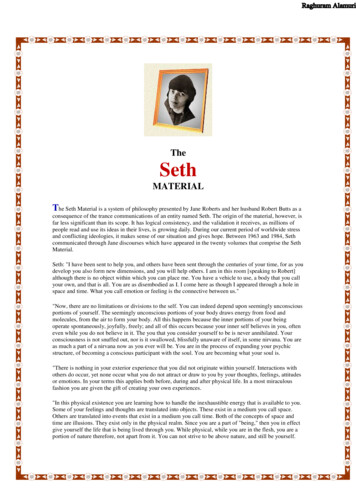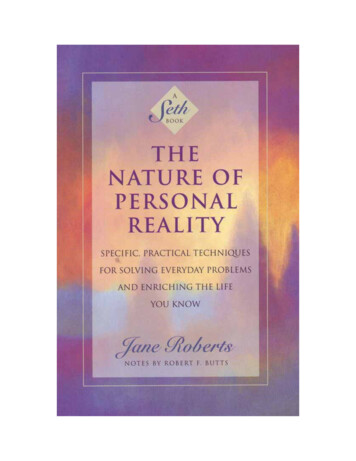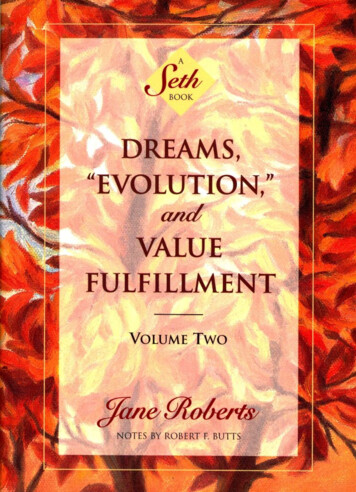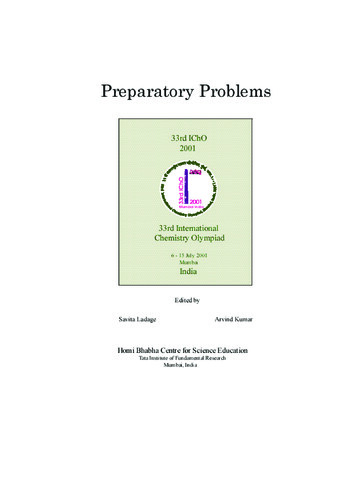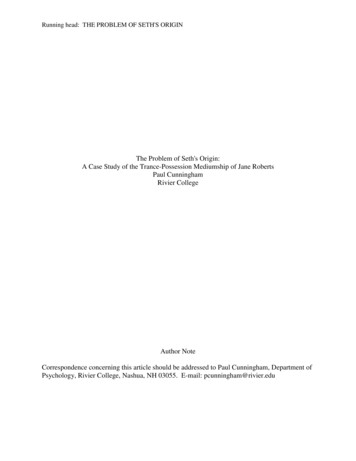
Transcription
Running head: THE PROBLEM OF SETH'S ORIGINThe Problem of Seth's Origin:A Case Study of the Trance-Possession Mediumship of Jane RobertsPaul CunninghamRivier CollegeAuthor NoteCorrespondence concerning this article should be addressed to Paul Cunningham, Department ofPsychology, Rivier College, Nashua, NH 03055. E-mail: pcunningham@rivier.edu
Running head: THE PROBLEM OF SETH'S ORIGIN2AbstractJane Roberts channeled the purported discarnate entity called "Seth" from 1963 through 1984.The purposes of this paper are to (a) discuss the question of whether the content of a mediumisticcommunication can aid in determining the source of that communication, (b) address a gap in theliterature by presenting an outer history of the trance-possession mediumship of Jane Roberts,and (c) examine eight explanations for Seth's origin in light of the published evidence of thecase, including fraud, cryptomnesia, hypnotic self-suggestion, incipient schizophrenia anddissociative identity disorder, high creativity, psi functioning, basic source Aspect, and energypersonality essence. Either Seth is or is not a production of Jane Roberts' psyche. In either case,we are led to the possibility that human personality may have a greater reality and greaterawareness than is generally supposed.Keywords: case study, mediums, mediumship, possession, trance, survival of consciousness,discarnate communication, content analysis.
Running head: THE PROBLEM OF SETH'S ORIGIN3The Problem of Seth's Origin:A Case Study of the Trance-Possession Mediumship of Jane RobertsOn December 8, 1963 an entity that called himself Seth emerged under the auspices of a ouijaboard to take possession of the body of a woman named Jane Roberts of Elmira, New York withthe expressed purpose of dictating information about the nature of reality beyond the five sensesin a trance-possession mediumship that lasted for 21 years. The mediumship of Jane Roberts istermed a "trance mediumship" because it occurred in a "sleep-like state" with characteristicdissociation, amnesia, and excursion of the ego (Sher, 1981, p. 108) in contrast to "mentalmediumship" that "occurs in a conscious and focused waking state" (Buhrman, 1997, p. 13). Thephenomenon is termed "possession" because "possession is a more developed form of motorautomatism in which the automatist's own personality does for a time altogether disappear, whilethere is a more or less complete substitution of personality;. . . speech being given by a spiritthrough the entranced organism" (Myers, 1903/1961, p. 345).Who or what is Seth and what is the origin of the Seth material? The purposes of this paper are to(a) discuss the "content/source" problem in modern mediumship research; that is, whether thecontent of mediumistic communications can be used to determine the source of thosecommunications -- whether normally, abnormally, or paranormally conceived, (b) address a gapin the parapsychological literature by presenting an outer history of Jane Roberts' trancepossession mediumship, and (c) critically examine several explanations for Seth's origin,including fraud, cryptomnesia, hypnosis, schizophrenia and dissociative identity disorder, highcreativity, psi functioning, basic source Aspect, and energy personality essence against evidencepresented in the published record of the case. One aim of providing a case study and criticalanalysis of a specific medium is to increase awareness of the trance-possession mediumship ofJane Roberts. A second aim is to serve as a thought experiment for investigators looking intoexplanations for the sources of information in mediumship and other similar phenomena.The Content/Source Problem in Mediumship ResearchKelly (2010) observed that mediumship "is the only phenomenon directly relevant to the survivalproblem that can be produced and observed under conditions of experimental control" (p. 248).Jane Roberts died on September 5, 1984 and Robert (Rob) Butts, her husband who transcribedverbatim all Seth trance sessions, died on May 26, 2008. What happens when the medium andher scribe are deceased and no longer available to be interviewed or studied in the usualscientific way that permits control, manipulation, and measurement in either a laboratory or fieldsetting? What significance can a mediumship continue to have after the medium is deceased interms of its bearing on controversial issues in psychical research, in furthering understanding ofthe dynamic nature of human personality, or in addressing the brain/consciousness problem andthe survival of consciousness hypothesis? Because Jane Roberts and her scribe are deceased, itis not possible to experimentally test any of the eight explanations about Seth's origin that areexamined in the paper except through rational analysis or thought experiment. How else mightthe problem of Seth's origin be approached if it is to meet with any real success? Can an analysisof the content of Jane Roberts ' mediumistic communications (the Seth material) provideevidence for the existence or nature of its claimed source (Seth)?
Running head: THE PROBLEM OF SETH'S ORIGIN4Myers' problem. The project of inferring Seth's discarnate status or independent and separateexistence from his medium, Jane Roberts, by a content analysis of the information contained inthe published record of the mediumship is problematical for at least two reasons. First, F. H. W.Myers (1889, 1892a, 1893), a founding member of the British Society for Psychical Research,long ago recognized that even if a discarnate personality external to the medium's own is thesource of the material, that material must first be communicated through subconscious levels ofthe medium's psyche. The conditions and manifestations of the communications would belimited by the capacity of the medium (e.g., medium's vocabulary) and colored by the medium'spersonal subconscious. Mediums are personalities and they must interpret the information theyreceive. There are no pure channels through which mediumistic information magically flows, inthose terms. This makes it difficult to distinguish between material whose origin is within themedium yet outside her (his) normal waking consciousness, and material whose origin is asource external to the medium's own psyche.Second, alternative explanations for the origin of mediumistic communications can always beconceived. Even corroborated evidential information received from persons recently deceasedand unknown to the medium giving facts connected to their identity which are afterwards foundto be correct in the complete absence of any sensory feedback (termed anomalous informationreception) would not of itself provide necessary and sufficient proof of identity of its source.Myers (1893) points out the problem:I have said that a message containing only facts normally known to the automatist mustnot, on the strength of its mere assertions, be regarded as proceeding from any mind buthis own. This seems evident; but the converse proposition is not equally indisputable. Wemust not take for granted that a message which does contain facts not normally known tothe automatist must therefore come from some mind other than his own. . . . Parallel withthe possibilities of reception of such knowledge from the influence of other embodied ordisembodied minds lies the possibility of its own clairvoyant perception, or activeabsorption, of some kind, of facts lying indefinitely beyond its supraliminal purview (pp.42-43).The analysis of mediumistic communications judged on the basis of its content alone has notbeen able to reliably differentiate between hypotheses of survival of consciousness andalternative parapsychological interpretations, such as survival psi, super-ESP, or psychicreservoir explanations -- even under so-called "ideal" experimental conditions (Beischel,2007/2008, pp. 62-63). The parapsychological research community has found it exceedinglydifficult to identify what conditions must be fulfilled in order for a mediumistic communicationto indicate prima facie the influence of a discarnate mind (Braude, 2003; Fontana, 2005; Gauld,1983). With regard to the dead, we have no independent knowledge of their condition.The problem of Seth's origin. Judgments concerning the credibility of the Seth material cannotbe separated from the question of its origin since constant reference is made to it throughout thematerial itself. Source cannot be divorced from content, practically speaking, since establishingproof of identity of the communicator is important in assessing the evidential character of thecommunication (Stevenson, 1978, pp. 326-327). In the present context of the Seth material,establishing proof of Seth's identity is important for determining (a) whether or not thecommunications will be valued and judged to be credible, (b) whether or not the communicationshave come from its attributed source, and (c) whether or not the communicator is believed to
Running head: THE PROBLEM OF SETH'S ORIGIN5exist. On the other hand, the content of the Seth material arguably can and should stand on itsmerits, regardless of its source.In the absence of an opportunity to study both Jane and Seth under conditions of experimentalcontrol, how does one establish proof of Seth's identity or ascertain the validity of hiscommunications? The problem is made more difficult by the two-fold fact that (a) the content ofthe published record does not provide sufficient veridical extrasensory information to proveSeth's discarnate character and (b) Jane Roberts' contact is with an entity that does not belong tophysical reality. In the absence of veridical extrasensory information and objective confirmationof the communicator's identity, how does one decide whether or not the Seth material representsa genuine communication from a discarnate entity? Before this question can be adequatelyaddressed, however, the conclusion that "the content of information cannot provide evidence forits source" (personal communication, J. Beischel, September 18, 2010) needs to be qualified andthe conditions that set limits or constraints on the conclusion identified.Messages by motor automatism. In his classic study of motor automatism, Myers' (1893)categorized the conceivable origin of written and other messages that professed to come fromsurvival personalities into four classes "judging by their definite contents alone" (p. 41): (a)messages that come from the channel's own mind and whose content is supplied from ordinarymemory or more extensive subliminal memory (pp. 41-43); (b) messages whose content isderived telepathically from the minds of other living persons who are either conscious orunconscious of transmitting the information (pp. 43-70); (c) messages whose content emanatefrom some "unembodied intelligence of unknown type" conventionally known as "guides" or"guardians" (pp. 70-106); and (d) messages whose content is ostensibly derived in a more or lessdirect manner from the mind of the discarnate personality from whom the communication doesactually claim to come (pp. 106-128). While the mere assertion that written or spoken messagescomes from a discarnate personality is no proof and one cannot accept communicators at theirface value, the content of a communication can provide the heuristic basis for arrangingmessages into a taxonomy of conceivable origins with some success.Phenomenology of mediumship. Myers' problem remains of determining the differencebetween information that originated solely from within the medium and information thatoriginated from an outside source that is "coterminous and continuous" -- to use William James'terminology -- with what is "within." (1902/1936, p. 499). Theoretically, a medium might betrained to introspectively tell the difference between her experience channeling information fromone source and an other. This is the goal of contemporary process-oriented mediumship researchdesigned to isolate the phenomenological processes underlying mediums' experiences duringdifferent kinds of discarnate communications. According to Rock, Beischel, & Schwartz (2008),A detailed understanding of these processes may, in turn, assist researchers with regardsto determining the source [emphasis added] of the purportedly non-local, non-sensoryinformation mediums receive. That is to say, the phenomenological elementsunderpinning discarnate communication readings might include the medium's sense ofwhether the discarnate is imaginal (i.e., a projection of the medium's mental set) orexosomatic (i.e., independent of the medium's mind-body complex), and whether or notdiscarnate communication is experienced as arising by the same mechanisms as doestelepathic communication for the living (Rock, Beischel, & Schwartz, p. 189).
Running head: THE PROBLEM OF SETH'S ORIGIN6Further developments in such triple-blind, process-focused mediumship research has thepotential of identifying what phenomenological conditions must be fulfilled in order for aphenomena to indicate prima facie the influence of a discarnate mind and to sufficiently advanceunderstanding of the mechanics of experience underlying discarnate communications to solveMyers' problem.The Analogy ApproachIn order to advance understanding of the content/source problem in mediumship research in acreative and productive way, the use of an analogy approach is recommended. The aim is toavoid stereotyped and functionally fixed thinking that can frame the content/source problem in anarrow and limited manner and block conceptual understanding of the problem space andperception of potential problem solutions. In the present context, the use of an analogy approachmeans looking at non-parapsychological content/source problems that have similar abstract,underlying meaning (structural features), but different superficial content and specific details(surface features). It means using the solution to similar, more familiar problems to help solveless familiar, more difficult ones (Gentner, Holyoak, & Kokinov, 2001). That is, can the study ofmore familiar analogical situations outside the field of mediumistic research (such as historicalstudies and literary analysis) show how rational analysis of documentary content to determine acommunication's source be productively applied to case studies of deceased mediums such asJane Roberts?For example, Sigmund Freud, Erik Erikson, Henry Murray, and Robert White have constructedlogically coherent and consistent psychobiographies of historically significant individuals bystudying prototypical scenes in the life of the subject and by using "salience markers" to identifysignificant patterns of life events (Elms, 1993; Schultz, 2005). Forensic analysis of theinformational content of a crime scene has aided investigators in determining the identity ofperpetrators. If the content of a communication is intelligible and reasonable, it suggests thatthat the source of the communication is both intelligent and rational. A communication expressedin written or spoken English implies that the communicator knows something about the surfacestructure and deep structure of the language. These examples illustrate some of the ways therational analysis of informational content have aided in a characterization of its source.Historical studies. Historians analyzing a document do attempt to determine its author byexamining its content (M. Menke, personal communication, October 26, 2010). For example,historians know that the speech given by Secretary of State Marshall at Harvard'scommencement in 1947 at which Marshall announced what became the Marshall Plan wasactually written by George Kennan. Historical scholars have attempted to determine who wrotewhat parts of the Old and New Testament on the basis of their study of Biblical texts. Historiansof ancient Greece have gone back and forth on the existence of a single "Homer" as author ofIliad and Odyssey on the basis of their study of the content of these literary documents.An example of the way that content analysis of a communication has allowed historians todetermine the fraudulent nature of its source occurred in the late 1980's when an individualclaimed to have discovered Hitler's diaries in a sealed case at the bottom of an Austrian lake. Thediary "find" followed only a few years after the publication of an authoritative edition of
Running head: THE PROBLEM OF SETH'S ORIGIN7Propaganda Minister Goebbels' diaries. The language and themes were very similar in bothdiaries. Historians know of Goebbels that he meant to use his diaries to project a desirable imageto posterity. Historians also know that Hitler wrote almost nothing in his own hand; he dictatedeverything to a corps of secretaries. The Hitler diaries contained very little personal informationbut did contain phrases and vocabulary probably not used before 1945 and not by an autodidactlike Hitler. Eventually the fraud was discovered and then confirmed by forensic analysis of thevolumes.Literary analysis. In the area of literary analysis, there are two situations where content hassuccessfully been used as an aid in determining its source (B. Stull, personal communication,October 26, 2010). One situation is where one has previous material by a known author and canlink the new, anonymous material to the material whose author is known. An example of thissituation would be if one has discovered an anonymous manuscript in an attic and the manuscriptseems to be in the style of John Steinbeck. It is then possible to read the anonymous manuscriptin light of known Steinbeck texts, and determine that the anonymous manuscript is a Steinbeck,or at least that it is plausibly a Steinbeck.A second situation where content has successfully been used as an aid in determining its sourceis where one does not have previous material by a known author, but can date material based oncontext and develop a series of categorizable themes, images, or metaphors that organize thenarratives and then assign them to an anonymous author "X." An example of this situationwould be documentary source work in Biblical studies. For instance, scholars saw that theGospel of John was substantially different than the other Gospels, which came to be known asthe "synoptic" Gospels. Ultimately, it was determined that the source of the synoptic Gospelswas "Q," which predates the Gospels of Matthew, Mark, and Luke. John did not draw on Q atall. The Gospel of Mark is seen to be the oldest of the Gospels, and thus closer to Q.A Documentary Approach to the Case of Jane RobertsOne would approach the case of Jane Roberts in a similar manner. By analyzing the content andstyle of the dictation of the Seth material and then comparing it to the abilities, knowledge, andmilieu of both the person "speaking" the text (Jane Roberts) and the person taking the dictation(Robert Butts), the investigator would try to establish whether or not it is likely that the channeland her scribe might have written the Seth material themselves. One would establish Seth's"voice" as a kind of origin such that Roberts' and Butts' usual, ordinary waking utterances wouldbe comparable in some way. Seth's dictated material would be compared with Jane's writtenbooks to see if they are the same author. This would permit investigators to exclude JaneRoberts and Robert Butts as authors of the Seth material and rule out the likelihood of fraud.Alternatively, the investigator might look at Jane Roberts's reports of her experiences during aSeth trance and compare its phenomenology with reports of her experience in non-Seth states ofconsciousness, as is done in contemporary process-oriented parapsychological research thatcompares mental mediums' experiences during ostensible communication with discarnates andduring psychic reading control conditions (e.g., Rock, Beischel, & Cott, 2008/2009; Rock &Beischel, 2008).
Running head: THE PROBLEM OF SETH'S ORIGIN8The investigator would then search for any other non-transcendent source of the Seth material.If no one but Seth could know this information, not Jane and not her husband, then is theinformation available in any scientific, philosophic, and psychological published documents or isit "made up"? That is, does the material contain facts not available to anyone else and notplagiarized? This would rule out the likelihood of cryptomnesia. Jane Roberts' fluent,mediumistic rendering of the world view of William James as recorded and transcribed, wouldbe compared stylistically to the original writings of William James. It would be difficult toverify Jane Roberts', Robert Butts, or Seth's alleged reincarnational lives because the writtenrecord does not appear to provide evidential data in sufficient detail to check against existinghistorical records and public documents.In order to use the content of the Seth material to argue a possible transcendent source, theinvestigator would need to make certain that the material contains information that could not beknown or surmised by someone else. That is, the source is the only one privy to thatinformation. Of course, to prove that Seth was really providing these communications, onewould need to believe in the possibility that personality and identity are not dependent uponphysical form. This requires an openness of mind and "an attitude of humility in relation to thepresent state of scientific knowledge" that not all investigators find easy to adopt (Kelly et al.,2007, pp. xxiii-xxviii). As Jon Klimo (1987) in his classic study of channeling observes: "Thescientist who stays open to the possible reality of channeling runs into this problem by holdingwhat McClenon (1984) calls "beliefs. . . that violate some of the [current] metaphysicalfoundations of science" (p. 206). Otherwise, investigators would limit themselves to adetermination that the source of the material remains unidentified.Truth-testing the content of the communications. Truth testing the content of Seth'scommunications will not allow investigators to determine conclusively the source of theinformation or its discarnate nature. Even if the Seth material does represents the subliminalactivity of Jane Roberts' psyche alone, however, it does not follow that such messages have nointerest or novelty for the psychologist. Since so many of humanity's brilliant and most practicaltheories have been attributed as coming from subconscious sources, it is reasonable to supposethat the Seth material may contain empirically verifiable propositions that could advance presentunderstanding of the nature of human personality and the characteristics of consciousness(Klimo, 1987, pp. 147-167, 303-319). "Whatever the origin, it is evident that this process ofchanneling has the capability of making important contributions to our knowledge andexperience" (Hastings, 1991, p. 25).Potentially verifiable/falsifiable predictions are presented throughout the Seth material that canbe evaluated by appropriate truth-tests. For instance, is telepathy the underlying basis for alllanguage comprehension? Do dream locations continue to exist even while awake (i.e., possessobject constancy)? Can "inaudible" sound be used to manipulate physical matter (e.g., conveymass and weight)? Does dividing a long sleep-wake cycle into two or three sleep cycles of lesserduration produce positive mental and physical health outcomes that conform to Seth's statedpredictions? To what degree do the multiple and diverse "practice elements" presented in theSeth material provide practical, therapeutic, psychological benefit for those who perform them?Does Seth's explanation of the mechanics of telepathy advance understanding of how telepathyoperates and how it may be developed? How might electromagnetic energy (EE) units and
Running head: THE PROBLEM OF SETH'S ORIGIN9consciousness units (CU) that are the hypothesized building blocks of physical matter be broughtwithin the range of scientific instruments? How can the multidimensional gateways that Sethcalls "Coordination Points," which are predicted to evoke electromagnetic anomalies, duration intime, puckering of space, and emotional intensities in people be detected? Are theredistinguishing marks by which false, doctored documents of early Christendom can beidentified? Do caves exist in the Pyrenees and in certain areas of Spain, Australia, and Africa thatcontain false ends behind which might be found remnants of an ancient civilization?A correspondence truth-test of Seth's predictions would involve (a) compiling a systematicsynopsis of the various fact-claims contained in the Seth material on topics connected with wellestablished academic disciplines, (b) identifying those propositions susceptible to qualitative orquantitative study, and (c) conducting appropriate descriptive, correlational, and experimentalresearch to determine the truth-value of the various fact claims. A coherence truth-test involvesconducting a content analysis of the Seth material to identify those propositions that are either inconcordance or inconsistent with recognized facts in established academic disciplines. Apragmatic truth-test involves assessing the consequences that the Seth material has produced inpromoting individual personality development and human transformative capacities. If theoutcomes of descriptive, correlational, and experimental studies can be predicted based onhypotheses derived from Jane's mediumistic communications with Seth, then it would provideevidence suggestive of clairvoyance on the part of Jane Roberts, even if it does not prove Seth'sdiscarnate status.Regardless of Seth's discarnate status, the outer history of the trance-possession mediumship ofJane Roberts and the Seth Material raise important questions about the nature of subconsciousperception, memory, cognition, affect, and motivation. Either Seth is or is not a production ofJane Roberts' psyche. In either case, we are led to the possibility that human personality mayhave a greater reality and greater awareness than is generally supposed.Outer History of the Mediumship of Jane RobertsFrom December 1963 through August 1984, Jane Roberts (1929-1984) of Elmira, New Yorkchanneled a purported discarnate entity that called himself Seth by a method called "automaticspeech" or "voice communication" while in a self-induced trance state of consciousness. Seth,who always claimed a separate and independent status from Jane Roberts, communicatedinitially through a ouija board on December 8, 1963 (Roberts, 1997b, pp. 21-25). By the 8thsession on December 15, 1963, Jane received answers to questions mentally before the boardspelled them out and began dictating the words sounded within her. By the 14th session, adeepening of Jane's voice and darkening of her eyes were observed during dictation, and at the26th session on February 28, 1964 the Ouija board was laid aside and Jane spoke for Seth for thefirst time before a witness (Roberts, 1997b, pp. 195-202). From then on, Seth spoke through JaneRoberts at scheduled days and times (usually twice a week on Monday and Wednesday around9:00 p.m., and otherwise spontaneously with Jane's permission). Seth continued to speakthrough Jane until August 30th, 1984 six days before her death of rheumatoid arthritis at the ageof 55 on Wednesday, September 5, 1984 at 2:08 a.m. after being bed-ridden at St. Joseph'sHospital in Elmira, NY for a year and nine months (Roberts, 1997a, pp. viii, 368-371).
Running head: THE PROBLEM OF SETH'S ORIGIN10Robert (Rob) Butts, Jane Roberts' husband, transcribed all Seth sessions verbatim as theyoccurred and supplemented the written record with notes that provide a psychosocial context forthe entire 21-year history of Jane Roberts' trance-possession mediumship. A visual record ofSeth speaking through Jane Roberts and a filmed interview of Jane and Robert Butts provideadditional evidential material (Butts, 1986). In 1970, The Seth Material was published and JaneRoberts went on a radio and television tour of seven cities to publicize the Seth material and Sethspoke on television in Boston, all of which introduced the Seth phenomenon to the wider publicfor the first time. The early Seth sessions from February 1964 through November 1969 werewitnessed by many individuals, including: editor Tam Mossman (Prentice Hall), hypnotistGeorge N. Estabrooks (Oswego State University College), psychologist Eugene Bernard (NorthCarolina University), physicist Norman Friedman, publisher Frederic Fell (New York),psychiatrist John O. Beahrs (New York), and associate editor Raymond Van Over(Parapsychology Foundation). Eyewitness reports by individuals who attended Jane Roberts'"ESP" class from 1972-1979 (Watkins, 1980, 1981) and a biography of the life of Jane Roberts(Watkins, 2001) supplement the published record. Original verbatim transcripts of all Sethsessions are available for public inspection in the Sterling Memorial Archives at Yale Universityand offer a good outer history of the case.Behavioral record. What would a witness observe if he (she) attended a typical Seth session?Jane could perform a variety of motor movements while in a Seth-trance, such as smoking acigarette, drinking wine, and striding across the room while speaking steadily for hours in longand complex narratives, without having any memory of what was said afterwards. When JaneRoberts "clicks out" into Seth, physical alterations are observed in her facial features, gestures,volume and accent of voice, word inflection, and a marked dilation of eye pupils. The followingdescription is provided by Rob Butts of the characteristic changes that occurred in Jane'sbehavior when she was in trance and speaking for Seth.Usually Jane goes in and out of trance with remarkable speed. Her eyes aren't closedduring sessions, except for relatively brief periods -- but they can be barely open, say, orhalf-open, or wide open and much darker than usual. She sits for sessions in her Kennedyrocker, but on occasion she gets up and moves about. She smokes in tr
Running head: THE PROBLEM OF SETH'S ORIGIN 3 The Problem of Seth's Origin: A Case Study of the Trance-Possession Mediumship of Jane Roberts On December 8, 1963 an entity that called himself Seth emerged under the auspices of a ouija board to take possession of the body of a woman named Jane Roberts of Elmira, New York with


